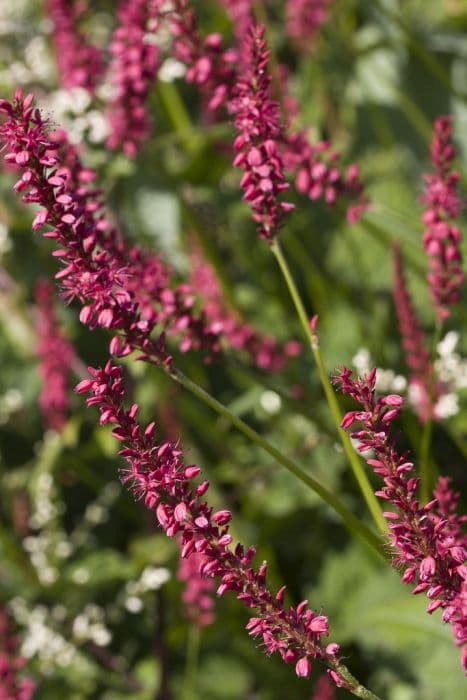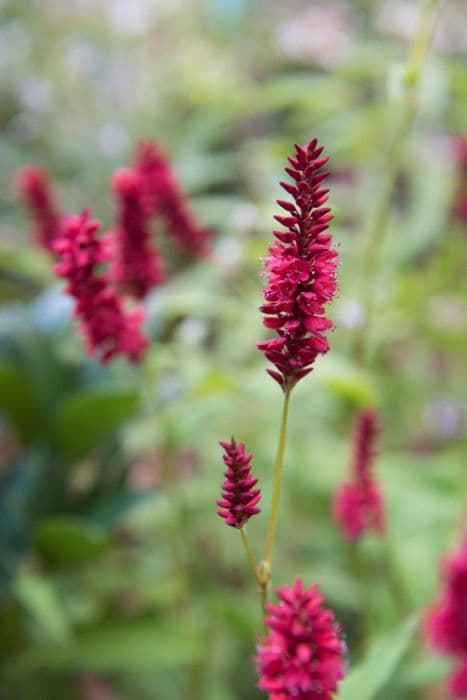Red bistort Persicaria amplexicaulis 'Firedance'

ABOUT
The 'Firedance' variety of this plant, often just referred to as Persicaria, is known for its vibrant and ornamental qualities. Its leaves boast a rich green hue and have a somewhat elongated and pointed shape. Throughout the blooming season, 'Firedance' produces a profusion of tiny, densely packed flowers that create slender, spike-like clusters. These flowers are typically a bold and eye-catching shade of pink or red, adding a dramatic pop of color to gardens. As the plant matures, the foliage may take on shades of bronzy-green, especially as the cooler weather arrives, which adds to its visual interest. This variety is considered to have a bushy growth habit, with the stems and leaves creating a lush backdrop for the brightly colored flower spikes. The combination of its striking flowers and attractive foliage makes Persicaria 'Firedance' a favorite among gardeners seeking to add continuous color and texture to their plantings throughout the growing season.
About this plant
 Names
NamesFamily
Polygonaceae.
Synonyms
Bistort, Mountain Fleece, Knotweed.
Common names
Persicaria amplexicaulis 'Fire Dance', Polygonum amplexicaule 'Firedance'.
 Toxicity
ToxicityTo humans
The Bistort is not commonly known to be toxic to humans. There are no significant reports or documentation on serious adverse reactions from ingestion or handling of this plant that would suggest a risk of poisoning in humans upon typical garden exposure.
To pets
The Bistort is also not widely reported to be toxic to pets. Similarly to humans, there is a lack of evidence indicating serious toxicity or poisoning in domestic animals like dogs and cats from ingestion. Standard precautionary measures should be observed to prevent pets from consuming plants as individual animals might have unique sensitivities.
 Characteristics
CharacteristicsLife cycle
Perennials
Foliage type
Deciduous
Color of leaves
Green
Flower color
Red
Height
3-4 feet (0.9-1.2 meters)
Spread
2-3 feet (0.6-0.9 meters)
Plant type
Herb
Hardiness zones
4-7
Native area
Himalayas
Benefits
 General Benefits
General Benefits- Long flowering period: The Persicaria amplexicaulis 'Firedance', commonly known as Mountain Fleece, typically blooms from summer into autumn, providing a long-lasting display of color.
- Attracts pollinators: Mountain Fleece is known for attracting bees and butterflies, which can help pollinate nearby plants.
- Low maintenance: This plant is appreciated for its minimal care requirements, making it a good choice for gardeners of all skill levels.
- Resistant to pests: Mountain Fleece is relatively resistant to pests and diseases, reducing the need for chemical treatments in the garden.
- Tolerates a range of soil types: Mountain Fleece can grow well in a variety of soil conditions, though it prefers moist, well-drained soils.
- Drought tolerant: Once established, it can tolerate periods of drought, making it suitable for drier climates or water-efficient gardens.
- Provides garden structure: With its bushy, upright habit, it adds structure and form to garden beds and borders.
- Colorful foliage: In addition to its flowers, the foliage of Mountain Fleece can provide visual interest with changing hues through the seasons.
- Easy to propagate: It can be easily propagated by division, allowing gardeners to create new plants for other areas of their garden or to share with others.
- Works well with other plants: Its flowers and foliage provide a beautiful backdrop and contrast to other plants in mixed garden settings.
 Medical Properties
Medical PropertiesThis plant is not used for medical purposes.
 Air-purifying Qualities
Air-purifying QualitiesThis plant is not specifically known for air purifying qualities.
 Other Uses
Other Uses- Pollinator attraction: Persicaria amplexicaulis 'Firedance' is excellent for attracting bees, butterflies, and other beneficial pollinators to the garden, helping to support the local ecosystem.
- Floral arrangements: The long, slender, and vibrant flower spikes can add a unique touch to floral arrangements and bouquets.
- Natural dye: The richly colored flowers and leaves can be used to produce natural dyes for fabric or paper crafting.
- Erosion control: Its dense growth habit makes it useful for stabilizing soil and preventing erosion on slopes or banks.
- Garden bordering: The plant's clumping form and striking flowers make it an ideal candidate for vibrant and structured garden borders.
- Photography: With its vivid flowers and large, leafy presence, it provides an excellent subject for garden and nature photographers.
- Educational tool: Can be used in educational settings to teach about plant growth, pollination, and the lifecycle of perennial plants.
- Rain garden inclusion: The species is suitable for rain gardens due to its ability to tolerate wet soil conditions.
- Livestock fodder: In some regions, it may be considered as a fodder plant for livestock, although this is not its primary use.
- Seasonal interest: Adding seasonal interest to the garden, its foliage and flowers provide texture and color changes throughout the growing season.
Interesting Facts
 Feng Shui
Feng ShuiThe Bistort is not used in Feng Shui practice.
 Zodiac Sign Compitability
Zodiac Sign CompitabilityThe Bistort is not used in astrology practice.
 Plant Symbolism
Plant Symbolism- Endurance: Persicaria amplexicaulis, commonly known as the Red Bistort, often symbolizes endurance due to its hardy nature and ability to thrive in a variety of conditions.
- Adaptability: The Red Bistort's easygoing attitude towards various soil types and sun exposures makes it a symbol of adaptability and versatility in different environments.
- Attraction: With its vibrant, fiery-hued flowers, the 'Firedance' variety of Red Bistort is frequently associated with attraction and drawing in positivity and interest.
 Water
WaterThe Mountain Fleece 'Firedance' prefers consistently moist soil and should be watered deeply once a week, providing 1 to 2 gallons of water each time, depending on weather conditions. During hot or dry spells, increase watering frequency to maintain soil moisture, but be careful not to overwater as this can lead to root rot. In cooler, wetter weather, you can reduce the water amount accordingly. Always check the top few inches of soil for dryness before watering to ensure the plant needs additional moisture.
 Light
LightMountain Fleece 'Firedance' thrives in full sun to partial shade conditions. It is best positioned in a spot where it can receive at least four to six hours of sunlight daily. However, in extremely hot climates, providing some afternoon shade will help protect the plant from scorching.
 Temperature
TemperatureMountain Fleece 'Firedance' is hardy and can withstand temperatures down to about -20°F, but it grows best in the range of 60°F to 75°F. It can survive in temperatures up to the 90s but will need additional care and watering in such conditions to prevent stress.
 Pruning
PruningPruning Mountain Fleece 'Firedance' primarily involves deadheading spent flowers to encourage further blooming and can be done as needed throughout the flowering season. Also, cut back the foliage in late fall or early spring to tidy up the plant and promote healthy, fresh growth. The best time for major pruning is in the spring before new shoots appear.
 Cleaning
CleaningAs needed
 Soil
SoilRed Bistort 'Firedance' thrives in a rich, moist, well-draining soil mix with a neutral to slightly acidic pH, ideally between 6.0 and 7.0. A mix containing garden soil, compost, and a bit of sand or perlite will provide the appropriate structure and nutrients for healthy growth.
 Repotting
RepottingRed Bistort 'Firedance' does not often require repotting as it is a herbaceous perennial that is usually grown in the ground. Instead of repotting, refresh the mulch and organic matter around the plant annually to maintain soil quality.
 Humidity & Misting
Humidity & MistingRed Bistort 'Firedance' performs well in average garden humidity and does not require any special humidity conditions. It is quite adaptable and tolerates the range of outdoor humidity levels typical of temperate climates.
 Suitable locations
Suitable locationsIndoor
Ensure bright light, moist soil, and good air circulation.
Outdoor
Plant in rich, moist soil, partial to full sun exposure.
Hardiness zone
4-8 USDA
 Life cycle
Life cyclePersicaria amplexicaulis 'Firedance'—commonly known as Bistort or Mountain Fleece—begins its life cycle as a seed which, after a period of winter dormancy, will germinate in the spring when soil temperatures rise. Upon germination, the seedling develops roots and shoots, growing into a young plant that forms a clump of foliage with characteristic large, oval leaves. Throughout the spring and summer, the plant matures and elongates spikes of tightly packed, tiny, reddish-pink flowers emerge and bloom, attracting pollinators. After the flowering period in late summer to early autumn, the plant sets seed which is then dispersed by various means, including wind and animals. As temperatures drop, Bistort enters a period of dormancy where above-ground growth dies back, but the roots remain alive underground. The following spring, the plant re-emerges from its rootstock to start the cycle anew, growing more extensive and robust with each passing year.
 Propogation
PropogationPropogation time
Early Spring
Persicaria amplexicaulis 'Firedance', commonly known as Red Bistort or Mountain Fleece, is often propagated by division in the spring or autumn. This popular method involves gently lifting the parent plant from the soil, using a spade or fork, and then carefully separating the clump into smaller sections, ensuring that each new section has a piece of the root system attached. Once divided, the sections can be replanted immediately into well-prepared soil, spacing them approximately 12 to 15 inches (about 30 to 38 centimeters) apart to allow sufficient room for growth. Watering should be done thoroughly after planting to help establish the new plants. Dividing Red Bistort not only helps to propagate new plants but also invigorates the parent plant, which can become congested over time.









